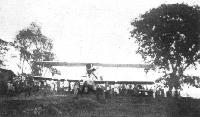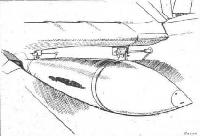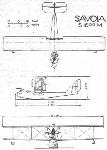
Варианты
- SIAI - S.16 / S.53 - 1919 - Италия
- Savoia-Marchetti / SIAI - S.57 / S.58 / S.59 - 1923 - Италия
- Savoia-Marchetti / SIAI - S.62 / МБР-4 - 1926 - Италия
SIAI S.16
Первая создававшаяся исключительно как пассажирская летающая лодка конструктора Рафаэля Конфленти получила название S.16 и была представлена общественности в 1919 году. Самолет был рассчитан на пять пассажиров и сохранил вогнутый корпус своих предшественников, но имел более элегантный внешний вид. S.16bis сохранил двигатель Fiat A.12bis, как и на S.16, но отличался усиленными корпусом и передними кромками крыльев, а также увеличенным запасом топлива и более крупным воздушным винтом.
S.16 сделал потрясающую карьеру на гражданской и военной службе, и может считаться одной из самых успешных летающих лодок своего времени. Военные модификации нашли своих заказчиков как внутри Италии, так и за границей. S.16bis M - военный вариант S.16bis, на котором имелись передняя кабина наблюдателя-стрелка и держатели для авиабомб под нижним крылом. Самолет имел колоссальный успех в 1920-е годы, а в середине 1920-х годов ВМС Бразилии приобрели 15 S.16bis M.
Самым важным эксплуатантом самолета стал СССР, который закупил около 80 машин - поставки осуществлялись двумя партиями. Самолеты получили обозначение С-1 бис и эксплуатировались в авиации Черноморского флота вплоть до 1931 года. Силами ОМОС (Отдел опытного морского самолетостроения) часть самолетов в 1927-1928 годах была модернизирована и получила обозначение С-1 тер. Основным отличием стала установка более мощных двигателей Lorraine-Dietrich мощностью 450 л. с.
Примерно 20 S.16bis M были поставлены в Испанию, некоторые машины оснащались двигателями Hispano-Suiza мощностью 300 л. с. Позже партия из 10 машин собиралась по лицензии в Барселоне, затем были размещены новые небольшие заказы.
S.16ter - военная модификация, разработанная по заказу ВМС Италии, поставки машин осуществлялись с 1924 года. Первыми самолеты получили эскадрильи 141 и 145, которые ранее летали на Macchi M.18, а затем они сменили S.16bis M в других подразделениях. Данная модификация оснащалась мотором Lorraine-Dietrich 12Db, строившимся по лицензии компанией "Isotta Fraschini" и развивавшим мощность 400 л. с.
Компания SIAI построила также один S.23 в качестве учебного варианта.
Описание:
- SIAI S.16
- Flight, February 1923
SOCIETA IDROVOLANTI ALTA ITALIA ("Savoia"), Sesto Calende. - Flight, August 1923
GOTHENBURG International Aero Exhibition 1923 - Flight, April 1925
THREE "SAVOIA" SEAPLANES
Фотографии
-
Flight 1925-04 / Flight
Three-quarter front view of the Savoia S.16ter, a bombing and reconnaissance flying boat fitted with a 400 h.p. Lorraine-Dietrich engine.
-
Flight 1923-07 / Flight
The S.I.A.I. (Savoia) S.16 Bis.M. flying boat, with 300 h.p. Fiat engine, one of many successful types of flying boats turned out by this Italian firm.
-
Мировая Авиация 45
Пятиместная летающая лодка Savoia S.16, построенная в 1919 году, предназначалась для военного и гражданского применения. Она стала одним из самых удачных гидросамолетов 1920-х годов.
-
Мировая Авиация 235
Полет на самолете S.16ter совершил знаменитый итальянский летчик генерал Франческо де Пинедо. На фотографии самолет запечатлен на реке Брисбен в Австралии примерно в мае 1925 года во время воздушного турне.
-
Aviation Historian 6
As a postscript to our article in TAH2 on Francesco de Pinedo’s long-distance flights, Phil Vabre of Melbourne-based The Airways Museum and Civil Aviation Historical Society (http://www.airwaysmuseum.com) sent this photograph of de Pinedo’s SIAI S.16ter flying-boat, probably taken at Sydney, during the 1925 Italy-Australia-China-Japan voyage.
-
Aviation Historian 2 / J.de Uphaugh - Lord of the Distances
A superb photograph of Gennariello on the River Tigris at Baghdad, where de Pinedo and Campanelli arrived after flying from Alexandretta (now Iskenderun) on the Mediterranean coast of Turkey, on April 25, 1925, five days after leaving Sesto Calende. The pair spent a day in Baghdad before setting off for Bushire (now Bushehr, part of Iran) on the 27th. Baghdad was visited again on November 3 on the return part of the voyage and it is not known on which occasion this photograph was taken.
-
Aviation Historian 2 / J.de Uphaugh - Lord of the Distances
The single-engined SIAI S.16 was a bold choice for de Pinedo’s 1925 voyage of some 35,000 miles, but the Marquis was determined to demonstrate that flying-boats were the aircraft of the future. Here Gennariello is seen at one of its stops on the journey, the (comparative lack of) dress of the helpers suggesting it is an Indian location.
-
Aviation Historian 2 / J.de Uphaugh - Lord of the Distances
Gennariello at Broome, Western Australia, on June 1, 1925, having arrived the previous day.
-
Aviation Historian 4
Australian servicemen pose with Francesco de Pinedo’s SIAI S.16ter at Guidonia, north-east of Rome, having found it there when the Italian capital was liberated in June 1944, 19 years after the flying-boat’s epic Far East flight.
-
Flight 1925-06 / Flight
The ltalian Rome-Australia Flight: Col. M.di Pinedo's Savoia S.16 ter flying boat (400 h.p. Lorraine-Dietrich) at the Air Survey Co.'s slipway at Rangoon (May 14 last).
-
Aviation Historian 31 / M.Wickstead - Italy's forgotten airlines (1)
Регистрационный номер: I-BAUV In December 1926 AEI acquired a pair of Savoia S.16ter five-seat flying-boats, I-BAUT (c/n 5148) and I-BAUV (c/n 5129). The latter is seen here undergoing maintenance on its single 400 h.p. Isotta-Fraschini-built Lorraine-Dietrich pusher-configured engine. The passengers and crew were accommodated in two open cockpits forward of the wings.
-
Авиация и Космонавтика 2012-04 / А.Артемьев - Морская авиация отечества (13)
Летающая лодка С-16бис
-
Авиация и Космонавтика 2012-06 / А.Артемьев - Морская авиация отечества (14)
Летающая лодка Савойя С-16бис
-
Мир Авиации 2002-01 / Л.Андерссон - Шведские авиаторы в России /Имена авиации/ (2)
Летающая лодка Savoia S.16, полученная Советской Россией при содействии Т.Гулльберга из Италии.
-
Мир Авиации 1998-02 / В.Котельников - МБР-4 - таганрогская "Савойя" /Авиадосье/
Летающая лодка S.16, предшественница S.62. 1931г.
-
Авиация и Время 1998-02 / В.Котельников, В.Куликов - "Итальянцы" в России: не на экране, а в воздухе /Аэроархив/
Подготовка к полету S.16ter Воздушных Сил Черного моря
-
Flight 1920-01 / Flight
The Savoia Flying Boat
-
Flight 1923-02 / Flight
The Savoia Flying Boat: Of the S.53 type, this Savoia carries pilot and six passengers. The engine is a 300 h.p. Fiat.
-
Flight 1920-01 / Flight
The tail of the Savoia flying boat is of somewhat unusual shape
-
Flight 1923-02 / Flight
ON THE SAVOIA FLYING BOAT: The wire strainers are enclosed in aluminium fairings.
-
Flight 1923-02 / Flight
The rudder crank on the Savoia is working partly inside a fairing.
-
Flight 1923-08 / Flight
ON THE SAVOIA: Sketch showing the suspension of one of the large bombs under the root of the lower plane.
-
Flight 1922-12 / Flight
Savoia 53
-
Flight 1923-08 / Flight
THE SAVOIA S.16 BIS M: General arrangement drawings to scale.
-
Flight 1925-04 / Flight
Savoia S.16t Bombing Flying Boat 400 hp Lorraine-Dietrich Engine
- Фотографии

























